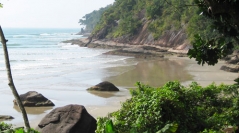

 Cryptogamie, Algologie
45 (6) - Pages 63-75
Cryptogamie, Algologie
45 (6) - Pages 63-75In this paper we present a bibliographical review of the newly described Brazilian cyanobacterial genera, based on 16S rDNA analysis. Moreover, we discuss their position according to the current classification system of Cyanobacteria. Additionally, in order to comprehend the diversity of Brazilian 16S rDNA sequences deposited in GenBank (NCBI), we constructed a phylogeny based on an alignment of these sequences with cyanobacterial reference strains. The bibliographical review resulted in 26 papers. We identified 30 cyanobacterial genera described from Brazil, distributed across eight orders. The order Nostocales is the most well-represented with 11 genera. The genera described based on Brazilian strains are from terrestrial, aquatic (marine and freshwater), and extreme habitats (alkaline saline lakes). The terrestrial habitat hosts the largest number of genera, with 17 in total. The studies are primarily concentrated in the Atlantic Rainforest, Amazon, Caatinga, and Pantanal Biomes, while the Pampa Biome remains unstudied. Most of the Brazilian genera are monophyletic, with the exception of Brasilonema Fiore, Sant’Anna, de Paiva Azevedo, Komarek, Kaštovský, Sulek & Lorenzi, which is intermixed with Iphinoe Lamprinou & Pantazidou and Symphyonemopsis Tiwari & Mitra; and Capilliphycus Caires, Sant’Anna & Nunes, which is polyphyletic. Genera like Marmoreocelis Machado-de-Lima & Branco, Monilinema Malone, Genuário, Vaz, Fiore & Sant’Anna, Insularia Araújo, Schnadelbach, Nunes & Caires, and Microlinema Araújo, Schnadelbach, Nunes & Caires require revision in their taxonomical classifications. Our findings reveal that numerous Brazilian 16S rDNA sequences in GenBank are unidentified or misidentified, indicating a need for at least 15 genera to be described based on these strains. Here we also elucidate that the Brazilian cyanobacterial diversity is significantly underestimated.
South America, Brazil, Tropical environments, Subtropical environments, cyanobacteria, phylogeny